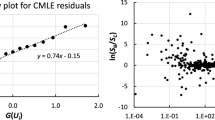Abstract
Over recent synchrotron experiments and publications we have devel- oped methods for measuring the absorption coefficient in the XAFS (X-ray Absorption Fine Structure) region and far from an edge in neutral atoms, simple compounds and organometallics which can reach accuracies of below 0.02%. This is 50–500 times more accurate than earlier methods, and 50–250 times more accurate than claimed uncertainties in theoretical computations for these systems. The data and methodology is useful for a wide range of applications, including dominant synchrotron and laboratory techniques relating to fine structure, near-edge analysis and standard crystallography. The experiments are sensitive to many theoretical and computational issues, including correlation and convergence of individual electronic and atomic orbitals and wavefunctions.
Similar content being viewed by others
References
J.H. Hubbell, NISTIR 5437 (NIST, Gaithersburg, MD, 1994)
J.H. Hubbell, J.S. Coursey, J. Hwang, D.S. Zucker, Bibliography of photon total cross section (attenuation coefficient) measurements (version 2.3) [online] Available: http://physics.nist.gov/photoncs (NIST, Gaithersburg, MD, 2003)
C.T. Chantler, J. Phys. Chem. Ref. Data 29, 597 (2000)
C.T. Chantler, J. Phys. Chem. Ref. Data 24, 71 (1995)
C.T. Chantler, et al., X-Ray Form Factor, Attenuation and Scattering Tables (v2.0) [Online], National Institute of Standards and Technology (Gaithersburg, MD, 2003)
M.J. Berger, J.H. Hubbell, S.M. Seltzer, J.S. Coursey, D.S. Zucker, XCOM: Photon Cross Section Database (v1.2) [Online] Available: http://physics.nist.gov/xcom (NIST Gaithersburg, MD, 1999)
M.J. Berger, J.H. Hubbell, NIST Stand. Ref. Datab. 8, 87, 3597 (2004)
E.B. Saloman, J.H. Hubbell, J.H. Scofield, At. Dat. Nucl. Dat. Tables 38 (1988)
J.H. Scofield, LLNL Report UCRI-51326 (1973)
D.C. Creagh, W. McAuley, Int. Tables for X-ray Crystallography, edited by A.J.C. Wilson (Kluwer, 1995)
B.L. Henke, E.M. Gullikson, J.C. Davis, At. Dat. Nucl. Dat. Tables 54, 181 (1993)
D.E. Cullen, J.H. Hubbell, L. Kissel, LLNL Report UCRL50400 (1997)
C.T. Chantler, in Resonant Anomalous X-Ray Scattering. Theory and Applications, edited by G. Materlik, K. Fischer, C.J. Sparks (Elsevier, North-Holland, 1994), pp. 61–78
C.T. Chantler, Rad. Phys. Chem. 41, 759 (1993)
D.C. Creagh, J.H. Hubbell, Acta Crystal. A 43, 102 (1987)
D.C. Creagh, J.H. Hubbell, Acta Crystal. A 46, 402 (1990)
C.T. Chantler, Rad. Phys. Chem. 55, 231 (1999)
C.T. Chantler, Z. Barnea, J. Phys. C 11, 4087 (1999)
C.T. Chantler, Z. Barnea, C.Q. Tran, J. Tiller, D. Paterson, Opt. Quant. Elec. 31, 495 (1999)
C.T. Chantler, C.Q. Tran, D. Paterson, D.J. Cookson, Z. Barnea, X-ray Spectrometry 29, 459 (2000)
C.T. Chantler, C.Q. Tran, D. Paterson, D. Cookson, Z. Barnea, Phys. Lett. A 286, 338 (2001)
C.Q. Tran, C.T. Chantler, Z. Barnea, D. Paterson, D.J. Cookson, Phys. Rev. A 67, 042716 (2003)
M.D. de Jonge, et al., Phys. Rev. A 71, 032702 (2005)
M.D. de Jonge, et al., Phys. Rev. A 75, 032702 (2007)
C.T. Chantler, C.Q. Tran, D. Paterson, Z. Barnea, D.J. Cookson, Rad. Phys. Chem. 61, 347 (2001)
C.T. Chantler, et al., Phys. Rev. A 64, 062506 (2001)
C.Q. Tran, et al., X-ray Spectrometry 32, 69 (2003)
M.D. de Jonge, Z. Barnea, C.T. Chantler, Phys. Rev. A 69, 022717 (2004)
C.T. Chantler, C.Q. Tran, D.J. Cookson, Phys. Rev. A 69, 042101 (2004)
N.A. Rae, C.T. Chantler, C.Q. Tran, Z. Barnea, Rad. Phys. Chem. 75, 2063 (2006)
C.T. Chantler, N.A. Rae, C.Q. Tran, J. Appl. Cryst. 40, 232 (2007)
C.Q. Tran, C.T. Chantler, Z. Barnea, M.D. de Jonge, Rev. Sci. Inst., 75, 2943 (2004)
M.D. de Jonge, Z. Barnea, C.Q. Tran, C.T. Chantler, Meas. Sci. Technol. 15, 1811 (2004)
C.Q. Tran, M.D. de Jonge, Z. Barnea, C.T. Chantler, J. Phys. B 37, 3163 (2004)
C.Q. Tran, et al., J. Phys. B: At. Mol. Opt. Phys. 38, 89 (2005)
L.F. Smale, C.T. Chantler, M.D. de Jonge, Z. Barnea, C.Q. Tran, Rad. Phys. Chem. 75, 1559 (2006)
J.L. Glover, C.T. Chantler, Meas. Sci. Tech. 18, 2916 (2007)
J.D. Bourke, C.T. Chantler, C. Witte, Phys. Lett. A 360, 702 (2007)
A. Mihelic, et al., Acta Chim. Slove. 51, 33 (2004); J.P. Gomilsek, et al., Phys. Rev. A 68, 042505 (2003)
J.L. Glover, C.T. Chantler, A.V. Soldatov, G. Smolentsev, M.C. Feiters, X-ray Absorption Fine Structure XAFS13, edited by B. Hedman, P. Pianetta (2007), pp. 625–627
J.J. Rehr (2008) (private communication)
Author information
Authors and Affiliations
Corresponding author
Rights and permissions
About this article
Cite this article
Chantler, C. Development and applications of accurate measurement of X-ray absorption. Eur. Phys. J. Spec. Top. 169, 147–153 (2009). https://doi.org/10.1140/epjst/e2009-00985-8
Published:
Issue Date:
DOI: https://doi.org/10.1140/epjst/e2009-00985-8




